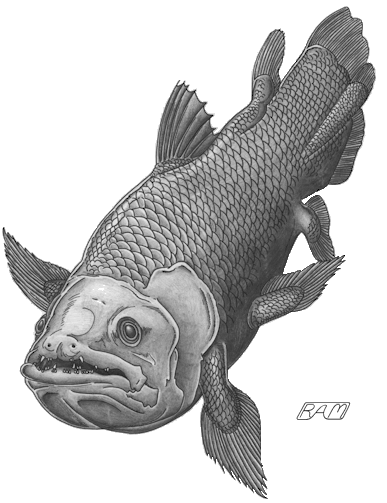Kao sto mozete procitati-procjenjuje se da je ova vrsta nastala prije 350 miliona godina i da je blizak rodjak prvim zivotinjama koje su izasle na kopno!


http://www.goosen.org/sa/discoa2.htmlCoelacanth - A Living Fossil
Imagine the excitement that was felt when a prehistoric fish, thought to be extinct for over 60 million years, was discovered alive in the waters off the tip of South Africa. No-one had suspected such a find, especially as palaeontologists and zoologists alike had been studying the fossilised remains of similarly ancient fish for years previous to the discovery. In terms of evolution, the ancient fish was more closely related to land animals than to fish . This find was acknowledged throughout the world as one of the greatest zoological discoveries ever made.
The coelacanth fish (until 1938) was thought to have died out during the great extinction of the dinosaurs at the end of the Cretaceous period. It was a stroke of luck that the fish was caught in fishing nets trawling the African coastline. If it were not for its strange appearance, the skipper of the trawler (Captain Hendrick Goosen) would most probably have left it buried beneath the fish that he had caught earlier that day. Its distinctive bulging blue eyes and heavy bluish scales alerted him to something quite unusual. Marjorie Courtenay-Latimer, curator of a klix museum in the port town of East London at South Africa's southernmost tip, was known by the locals to be fascinated by unusual marine fish. She was always anxious to increase her collection of specimens to show off the local wildlife found in the area. She was often called upon to inspect something slightly out of the ordinary, and that day was no different to any other. On reaching the trawler she was completely overwhelmed by what she saw, and later wrote that the fish was "the most beautiful fish I had ever seen, five feet long, and a pale mauve blue with iridescent silver markings." She transported the specimen back to the museum and at once set about contacting Professor J. L. B. Smith, a lecturer at Rhodes University known to have a passion for fish. On receiving the news, his response was immediate: "MOST IMPORTANT PRESERVE SKELETON AND GILLS = FISH DESCRIBED." However, in an attempt to preserve the fish by mounting it, the innards had been discarded.
The fish was a so-called "living fossil". It was identified as belonging to the class of fish that appeared 350 million years ago, being closely related to the first four-limbed land animal. By studying the fish it was apparent that it used its strange fins for swimming in a motion similar to walking. The lobe-like fins actually had jointed bones, like arms and legs.
On finding out that the specimen had no internal organs, Smith became obsessed in finding a second specimen. Prepared to pay a reward of £100, he patiently waited for a further discovery. Fourteen years later, on 21st December1952, a fisherman brought another specimen (caught off the Comoros Islands to the northwest of Madagascar) to Captain Hunt, a young captain who was assisting Smith with his search for the coelacanth. On recognising the fish, Hunt immediately arranged for Smith's reward of £100 to be paid. Smith was instantly sent for, and within a couple of days he arrived. He had been waiting for this moment since 1938, and the anticipation of seeing this specimen was just too much. When he saw the dead fish he wept with happiness. It was indeed a coelacanth. He now had his second specimen with its organs intact. The familiarity of the Comoro natives with this specimen meant that at least one location of the coelacanth's habitat had been discovered. In 1956 Smith published a book on the coelacanth called "Old Four Legs".
Since the 1952 discovery there have been several coelacanth sightings. In 1987 the coelacanth was filmed underwater in its natural habitat for the first time.
The coelacanth will always be considered a remarkable discovery. Somebody once said that finding a living dinosaur would be no more amazing than the finding of the coelacanth.
